With the release of Nvidia’s new GeForce GTX 680, we at UKGC thought we’d get our hands on one to put it through its paces, to see how it compares to its predecessor, the GTX 580.
Each year, Nvidia and AMD/ATI battle it out for video card supremacy. Nvidia have continued their trend with the release of the GTX 680, and it would seem they have pulled all the stops out on this card, with a stylish look that packs a punch while maintaining control over its power usage.
Raw Power
The GTX has a standard clock speed of 1,006MHz, but it doesn’t stop there, Nvidia have put a GPU boost technology into the new GTX 680. It is similar to the turbo boost found in the latest chipsets from Intel and AMD where when a temporary over clock is needed; the chip will recognise this and give itself an extra boost. The average boost will run to 1.058MHz, it can go higher if needed, with Nvidia claiming to have gotten 1.1MHz out of the 680. Compare this to the GTX 580, the frequency is 772MHz, without the power of GPU boost. This means that as standard, the new 680 runs just under 20% faster than the 580 as standard; when needed, it can boost itself to run even faster!
As for power needed to run the 680, it is recommended that the 680 has 550 watts of power, compare this again to its predecessor, the 580, which needs 600 watts of power to run. It is a card that does more for less, showing that Nvidia have taken it seriously when it comes to power saving for the new 680.
Display
The display ports on offer aren’t surprising, two dual link DVI slots, one HDMI port and one Display port. It’s pretty standard, which in this case is a good thing, with VGA now being almost dead, DVI are the ports all the new cards have. Compare that to the 580, the ports are pretty similar, two dual DVI ports, one HDMI ports and a mini HDMI port which is along the same sort of lines as the 680.
One big plus the 680 has display wise, is that it is Nvidia’s first single graphics card that can run 4 monitors without requiring another card! Once again, compared to the GTX 580, and previous GeForce graphics cards you are only able to hook up 2 displays off of a single GPU. Like AMD/ATI have called their technology, Eyefinity, Nvidia call it surround vision.
Looks
Two notable changes for the GTX 680. The first noticeable one is that Nvidia have reduced the size of the card, a good stride forward, reducing the size to 10 inches from the normal 11 inches for the flagship card. Not a massive change in size, but it does allow the cards to fit into smaller spaces that they wouldn’t have been able to before, also taking up less space will mean that there is more room for ease of airflow.
Another notable change is the PCI pins needed for the card, rather than an eight pin connector and a 6 pin connector needed, surprisingly, the 680 only needs two six pin connectors. Staying on the subject of pin connectors, the pin connectors aren’t simultaneously next to each other along the length of the card like they normally are, instead they are rotated 180 degrees and stacked on top of each other along the width. An attempt to remove clutter to the machine but it does make it more difficult to get the connections out.
GTX 680 Benchmarks
So, with all said and done, it’s time to get down to what really matters, performance of one of these bad boys. How does the GTX 680 do when it’s put to work? We tested it on 4 different games on three different resolutions to see when and if it has a breaking point. We tested it on Call of Duty: Modern Warfare 3, Battlefield 3, Metro 2033 and The Elder Scrolls V: Skyrim.
Call of Duty: Modern Warfare 3
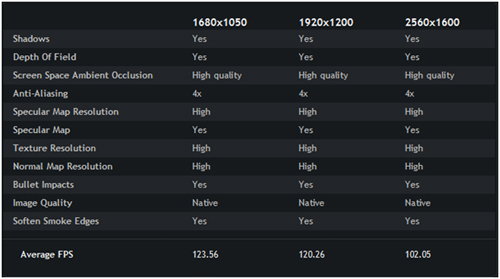
Battlefield 3
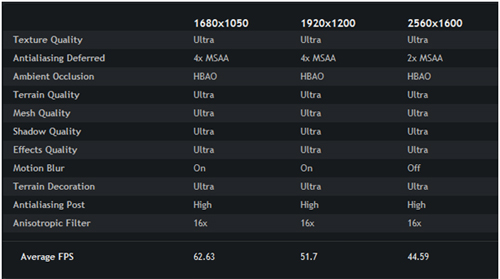
The Elder Scrolls V: Skyrim
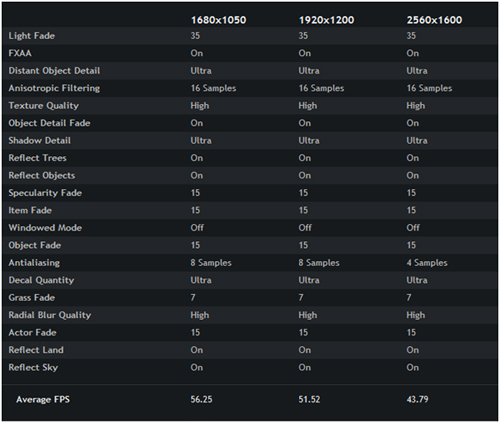
Metro 2033
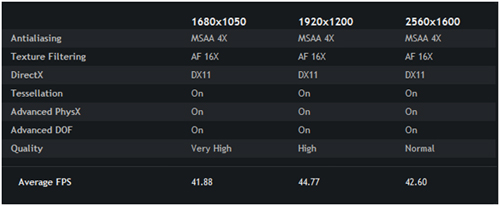
From looking at the 4 tables, we changed only a few settings to get the very best performance, with the exception of one, each of the changes that have been made have been on the 2560x1600 resolution setting. The one change we made on the 1920 x1200 setting actually managed to get the average fps higher than that of a 1680x1050 resolution setting. Apart from this one (Metro 2033), the smaller resolution settings give of more fps as would be expected.
For Call of Duty: Modern Warfare 3, we managed to keep the max settings all the way through and it handled the game no problem even on the maximum resolution. On Battlefield 3, The Elder Scrolls V: Skyrim and Metro 2033 we have had to change a few settings, generally on the top resolution, so that the game gave off as crisp a picture as it possibly could.
What we were also interested in seeing was the comparison between the 680 as compared to other cards. We put it through its paces and set up 7 configurations on battlefield 3 on ultra settings.
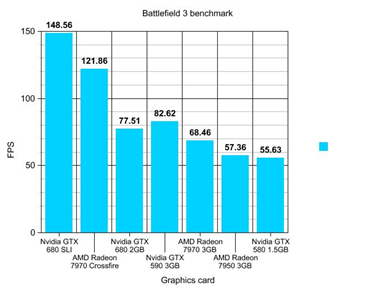
Our results are as follows. The 680 in SLI mode took the honours as we expected it too. An impressive 148.56 fps for what is probably the most demanding game currently on the market. Coming second was the AMD Radeon 7970 in Crossfire mode getting an impressive 121.86FPS; the two newest flagships on the market take the chart by storm. As for stand-alone graphics cards, the 590 comes in ahead of the 680, although the 590 is a dual core graphics card, so in that view, it would probably be expected, the 590 gets 82.62 FPS and the 680 gets 77.51 FPS. The 7970 falls just behind the 680 with 68.46 FPS, the 7950 gets 57.36 FPS and the 580 gets 55.63 FPS. So looking at this, the 680 is better than its predecessor, the 580, as a card we would say it is better than the 590 as it is a single core going up against a dual core, still ending up pretty close, if Nvidia do release a new dual core card, expect that to be a bit of a beast.
Overall
Let’s go over what we have reviewed. The 680 has a faster standard clock speed than the 580, with the capability to auto over clock itself, something a graphics card has never been able to do previously. The 680 needs 550 Watts of power compared to the 600 needed for the 580. The 680 has a technology called Nvidia surround 3D vision, where the single card can run 4 monitors simultaneously. It is an inch smaller than the 580, creating more room for air flow and it completely destroys the top games on the market currently. If anyone is looking for the best graphics card around for their custom PC, that will future proof them for years to come, look no further than the Nvidia GeForce GTX 680.

